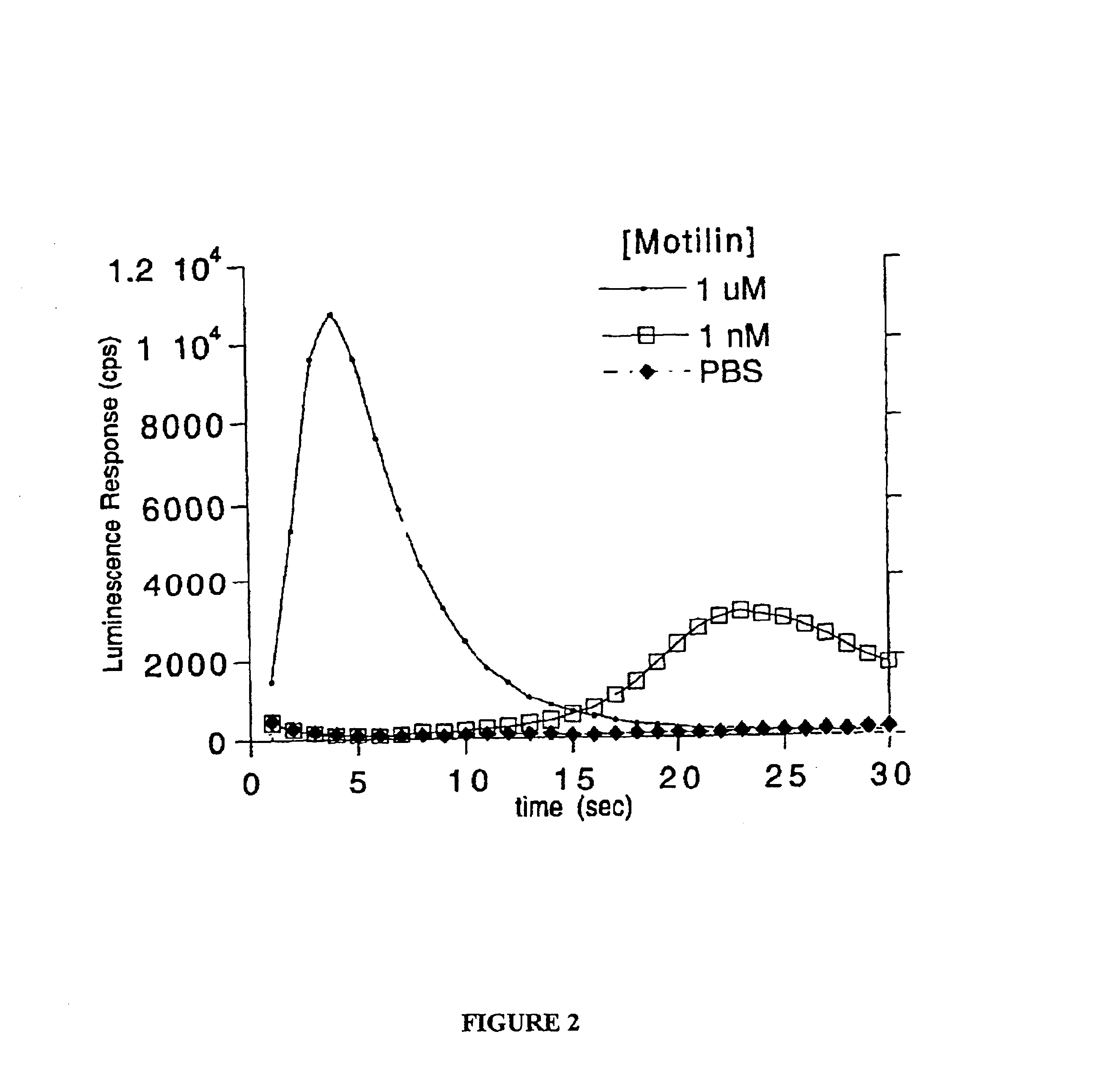Method for evaluating therapeutic efficacy
a therapeutic efficacy and method technology, applied in the field of method for evaluating therapeutic efficacy, can solve the problems of huge failure of potential drugs in clinical phase, and the effect of receptors for different hormones that act on a single signaling pathway may be less
- Summary
- Abstract
- Description
- Claims
- Application Information
AI Technical Summary
Benefits of technology
Problems solved by technology
Method used
Image
Examples
example 1
Co-Expression of a GPCR and Aequorin in a Cell Line and Potency Measurement
A gene encoding the target receptor is cloned and placed into a mammalian expression vector such as pcDNA3.1. The gene may be synthetic or naturally derived. Next, pmtAEQ, an aequorin expression plasmid available from Molecular Probes, and the receptor expression construct are transfected into HEK293 cells using a commercially available transfection kit such as Lipofectamine Plus (Gibco BRL). At this point, a stable cell line may be selected from the transfection mix using common techniques, or the heterologous mixture obtained from transient transfection may be used directly. Cells expressing aequorin and the target receptor are then harvested and soaked in a solution of phosphate buffer saline containing 0.1 g / L CaCl2, 0.1 g / L MgCl2, 36 mg / L pyruvate, and 1 g / L glucose (in phosphate buffer solution (“PBS”)) with 2.5 μM coelenterazine f and 300 uM reduced glutathione for 0.5-4 hours. The cells are washed and...
example 2
Desensitization Measurement in a Cell Line Coexpressing GPCR and Aequorin
Cells expressing a target receptor and aequorin are grown, harvested and counted. Cells are then incubated in PBS with varying concentration of test compound in a 1 mL reaction containing 500,000 cells. The reaction is incubated at 37° C. for a set amount of time (initially varied to determine the time dependence of desensitization). The reaction is diluted, cells are separated from the test compound by centrifugation, resuspended (in PBS containing 0.1 g / L CaCl2, 0.1 g / L MgCl2, 36 mg / L pyruvate, and 1 g / L glucose) and recentrifuged to wash away any remaining test compound. To reconstitute the aequorin cofactor, the cells are then resuspended in 5 mL of PBS containing 2.5 uM coelenterazine f and 300 uM reduced glutathione, and incubated at 37° C. for 30-45 minutes. The cells are centrifuged once more, then resuspended in 800 uL of PBS for assay.
100 μL of cells are placed in the well of a 96-well white assay pla...
example 3
Expression of the Motilin Receptor and Aequorin
A synthetic gene encoding the motilin receptor was designed using common methods based upon the sequence of the naturally occurring human motilin gene. An error in the synthesis was corrected to give Kos127-42-61, a pUC derived vector containing a synthetic gene encoding the motilin receptor. The HindIII / EcoRI fragment of pkos127-42-61, containing a fully sequenced synthetic gene encoding the human motilin receptor and an upstream Kozak sequence was subcloned into the pcDNA3.1(+) expression vector. The resulting plasmid construct (pkos127-159) was verified by restriction analysis and DNA sequencing.
HEK293 cells (ATCC CRL-1573) were grown to ˜95% confluence in T175 flasks at 37° C. in an atmosphere containing 5% CO2. Each T175 flask was transfected with a total of 11.5 ug of DNA using the Lipofectamine Plus reagents and the protocol supplied by the manufacturer. For transient transfections, the ratio of pkos127-159 (“motilin receptor DNA...
PUM
| Property | Measurement | Unit |
|---|---|---|
| time | aaaaa | aaaaa |
| concentration | aaaaa | aaaaa |
| luminescence response | aaaaa | aaaaa |
Abstract
Description
Claims
Application Information
 Login to View More
Login to View More - R&D
- Intellectual Property
- Life Sciences
- Materials
- Tech Scout
- Unparalleled Data Quality
- Higher Quality Content
- 60% Fewer Hallucinations
Browse by: Latest US Patents, China's latest patents, Technical Efficacy Thesaurus, Application Domain, Technology Topic, Popular Technical Reports.
© 2025 PatSnap. All rights reserved.Legal|Privacy policy|Modern Slavery Act Transparency Statement|Sitemap|About US| Contact US: help@patsnap.com



